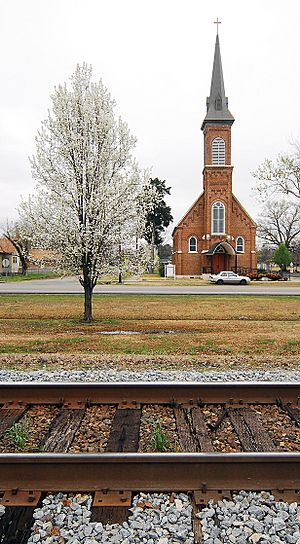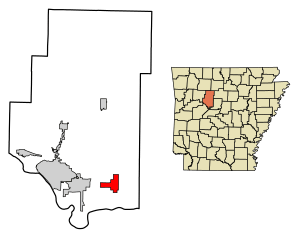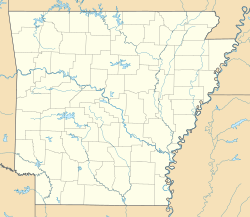Atkins, Arkansas facts for kids
Quick facts for kids
Atkins, Arkansas
|
|
|---|---|
|
City
|
|

Atkins Roman Catholic Church of the Assumption
|
|

Location of Atkins in Pope County, Arkansas.
|
|
| Country | United States |
| State | Arkansas |
| County | Pope |
| Area | |
| • Total | 6.14 sq mi (15.89 km2) |
| • Land | 6.13 sq mi (15.88 km2) |
| • Water | 0.01 sq mi (0.01 km2) |
| Elevation | 367 ft (112 m) |
| Population
(2020)
|
|
| • Total | 2,859 |
| • Density | 466.39/sq mi (180.09/km2) |
| Time zone | UTC−06:00 (Central (CST)) |
| • Summer (DST) | UTC−05:00 (CDT) |
| ZIP Code |
72823
|
| Area code(s) | 479 |
| FIPS code | 05-02590 |
| GNIS feature ID | 2403125 |
Atkins is a city located in Pope County, Arkansas, United States. In 2020, about 2,859 people lived there. It is part of the larger Russellville area.
Contents
Where is Atkins?
Atkins is located in the state of Arkansas, USA. It covers a total area of about 6.1 square miles (15.8 square kilometers). All of this area is land. Many people who live in Atkins travel to nearby Russellville for work, school, and fun activities.
A Look at Atkins' History
Atkins was named after Elisha Atkins. He was a sugar importer from Boston. He helped pay for the Little Rock and Fort Smith Railroad. This railroad helped the town grow a lot after the American Civil War. The town was officially planned out in 1872.
Atkins built its first school in 1875. By 1894, it even had its own newspaper called the Atkins Chronicle. The town was an important place for cotton. Many cotton gins, which separate cotton fibers from seeds, operated there. In 1927, the Arkansas River flooded and damaged the town. Over time, new roads were built, which caused the town to shift its main direction away from the river.
The "Pickle Capital"
Atkins was once home to the Goldsmith Pickle Company. This company started making pickled cucumbers in 1946. Because of this, the town proudly called itself the “Pickle Capital of the World.” About 1,200 acres of land were used to grow cucumbers for the company.
Atkins is also where the fried dill pickle was invented! A person named Bernell “Fatman” Austin created this tasty snack. The pickle plant changed owners over the years. In 2002, the plant closed down. However, it left a fun tradition behind: the two-day "Picklefest." This festival is still held every May.
People of Atkins
Population Changes Over Time
| Historical population | |||
|---|---|---|---|
| Census | Pop. | %± | |
| 1880 | 519 | — | |
| 1890 | 660 | 27.2% | |
| 1900 | 745 | 12.9% | |
| 1910 | 1,258 | 68.9% | |
| 1920 | 1,529 | 21.5% | |
| 1930 | 1,364 | −10.8% | |
| 1940 | 1,322 | −3.1% | |
| 1950 | 1,291 | −2.3% | |
| 1960 | 1,391 | 7.7% | |
| 1970 | 2,015 | 44.9% | |
| 1980 | 3,002 | 49.0% | |
| 1990 | 2,834 | −5.6% | |
| 2000 | 2,878 | 1.6% | |
| 2010 | 3,016 | 4.8% | |
| 2020 | 2,859 | −5.2% | |
| U.S. Decennial Census 2014 Estimate |
|||
The number of people living in Atkins has changed over the years. You can see how the population has grown and shrunk from 1880 to 2020 in the chart above.
Atkins Today (2020 Census)
In 2020, there were 2,859 people living in Atkins. There were 1,164 households, which are groups of people living together. Out of these, 759 were families.
Most people in Atkins are White (89.4%). There are also smaller groups of Black or African American people (0.73%), Native American people (0.66%), and Asian people (0.24%). About 5.46% of people are of mixed races or other races. Also, 3.46% of the population is Hispanic or Latino.
Life in Atkins (2010 Census)
In 2010, there were 3,016 people living in Atkins. The city had 1,118 households. About 30.4% of these households had children under 18 living with them. More than half (53%) were married couples. About 25.3% of households had only one person living there.
The average age of people in Atkins was 38.8 years. About 23.4% of the population was under 18 years old. About 17.7% of people were 65 years or older.
The average income for a household in Atkins was about $40,112 per year. For families, the average income was about $49,754. About 8.8% of all people in Atkins lived below the poverty line. This included 6.3% of children under 18.
Notable People from Atkins
- Ellis Kinder: A famous baseball pitcher who played in the major leagues. He was born in Atkins.
- Wilson Matthews: A former assistant football coach for the University of Arkansas. He was also from Atkins.
- Norris Church Mailer: A writer who was married to the famous author Norman Mailer.
See Also
 In Spanish: Atkins (Arkansas) para niños
In Spanish: Atkins (Arkansas) para niños


